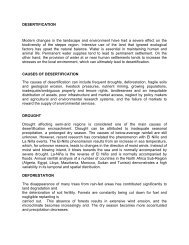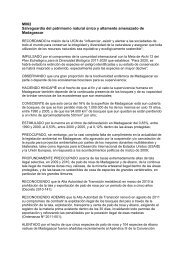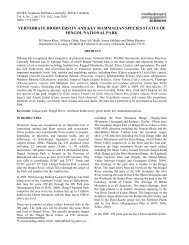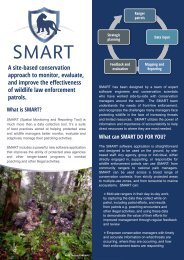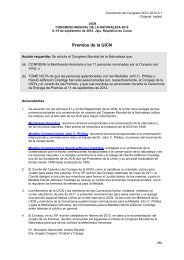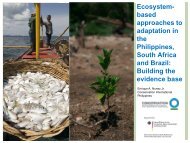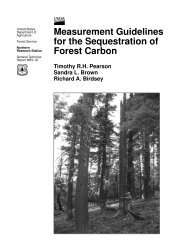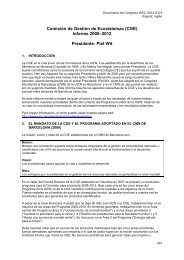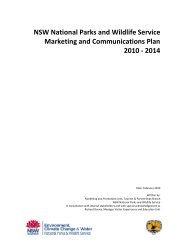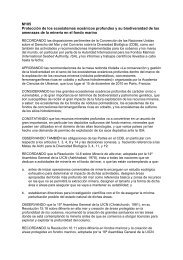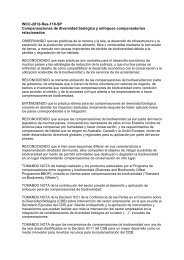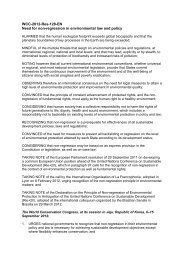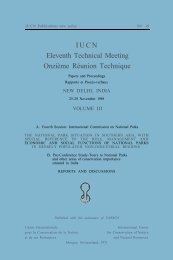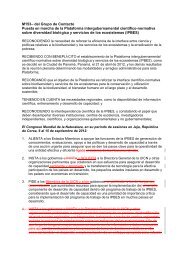Commission on Ecosystem Management (CEM ... - IUCN Portals
Commission on Ecosystem Management (CEM ... - IUCN Portals
Commission on Ecosystem Management (CEM ... - IUCN Portals
You also want an ePaper? Increase the reach of your titles
YUMPU automatically turns print PDFs into web optimized ePapers that Google loves.
C<strong>on</strong>gress Document WCC-2012-8.2/2<br />
<str<strong>on</strong>g>Commissi<strong>on</strong></str<strong>on</strong>g> <strong>on</strong> <strong>Ecosystem</strong> <strong>Management</strong> (<strong>CEM</strong>)<br />
Report 2008–2012<br />
Chair: Piet Wit<br />
1. INTRODUCTION<br />
<strong>CEM</strong> is <strong>IUCN</strong>‟s youngest commissi<strong>on</strong>. It was established in 1996 by the Members‟ Assembly at<br />
M<strong>on</strong>treal (Canada), where Ed Maltby was elected its first Chair. <strong>CEM</strong> can be c<strong>on</strong>sidered the<br />
successor of the <str<strong>on</strong>g>Commissi<strong>on</strong></str<strong>on</strong>g> <strong>on</strong> Ecology (COE) that was dismantled at that same event.<br />
Hein van Asperen became <strong>CEM</strong>‟s sec<strong>on</strong>d chair in 2000 though for pers<strong>on</strong>al reas<strong>on</strong>s he had to retire<br />
after six m<strong>on</strong>ths. Hillary Masundire then took over and did two terms, to be replaced by the present<br />
Chair Piet WIT. Piet Wit was elected at WCC-Barcel<strong>on</strong>a and at WCC-Jeju will be eligible for a sec<strong>on</strong>d<br />
term. This report summarizes <strong>CEM</strong>‟s highlights and challenges of the intersessi<strong>on</strong>al period between<br />
Barcel<strong>on</strong>a and Jeju.<br />
In this narrative report, I will try to guide the reader through the results of our work by framing our<br />
activities within the c<strong>on</strong>text of <strong>IUCN</strong>‟s global programme, and not so much to fall back to a dull<br />
enumerati<strong>on</strong> of activities undertaken and results produced.<br />
For more background informati<strong>on</strong>, the reader is referred to our web-page:<br />
http://www.iucn.org/about/uni<strong>on</strong>/commissi<strong>on</strong>s/cem/<br />
2. THE <strong>CEM</strong> MANDATE AND PROGRAMME ADOPTED AT WCC-BARCELONA (2008)<br />
<strong>CEM</strong>‟s missi<strong>on</strong>, visi<strong>on</strong> and objective as defined by its mandate adopted by WCC-Barcel<strong>on</strong>a:<br />
Missi<strong>on</strong>:<br />
To provide expert guidance <strong>on</strong> integrated approaches to the management of natural and modified<br />
ecosystems to promote biodiversity c<strong>on</strong>servati<strong>on</strong> and sustainable development<br />
Visi<strong>on</strong>:<br />
Healthy ecosystems support life and sustain development<br />
Objective:<br />
<strong>Ecosystem</strong> approaches to natural resources management mainstreamed worldwide<br />
A <strong>CEM</strong> steering committee workshop in Çolombia in 2007 formulated a very ambitious <strong>CEM</strong><br />
programme for the period 2008–2012. Under each of the five programme areas of <strong>IUCN</strong>, the <strong>CEM</strong><br />
programme identified realistic c<strong>on</strong>tributi<strong>on</strong>s to the <strong>IUCN</strong> objectives. It was realistic in the sense that if<br />
funding could be found, our volunteer network could be mobilized to deliver the products as identified.<br />
In spite of the global financial crisis that did not bypass <strong>IUCN</strong> or <strong>CEM</strong>, we did well in most of the <strong>IUCN</strong><br />
Programme Areas for 2008–2012. In general terms we did relatively well <strong>on</strong> Core Programme Area 1<br />
(“C<strong>on</strong>serving biodiversity”) and Thematic Programme Areas 2 (“Changing the climate forecast”), 4<br />
(“Managing ecosystems for human well-being”) and 5 (“Greening the world ec<strong>on</strong>omy”). Little has been<br />
d<strong>on</strong>e in Programme Area 3 („Naturally energising the future”).<br />
It has to be observed that at the level of individual products under the five priority areas, we have been<br />
over optimistic as to what could have been achieved by the volunteer network with the limited funding<br />
that <strong>CEM</strong> receives. Generating ideas that inspire and bring enthusiasm is not our problem, translating<br />
these into c<strong>on</strong>crete acti<strong>on</strong>s and products is a different story. Future planning should be more modest<br />
in its expectati<strong>on</strong>s.<br />
378
3. STRATEGIC AND TACTICAL CONSIDERATIONS<br />
At the <strong>on</strong>set a number of strategic and tactical measures were taken that would strengthen <strong>CEM</strong> and<br />
facilitate its members to c<strong>on</strong>tribute to the <str<strong>on</strong>g>Commissi<strong>on</strong></str<strong>on</strong>g>‟s goal.<br />
‣ Strengthening <strong>CEM</strong> membership<br />
In 2008, <strong>CEM</strong> had about 400 members. In many regi<strong>on</strong>s and thematic programmes the number of<br />
members was simply too small to make a difference. In volunteer networks like ours, <strong>on</strong>e needs to<br />
have a large enough number of members to be sure that expertise can be mobilized when it is asked<br />
for. In 2012 we have more than 800 members.<br />
We have also made a special drive to recruit more young professi<strong>on</strong>als as members of <strong>CEM</strong>. Young<br />
professi<strong>on</strong>als bring in new ideas, more energy and often have more time available compared to older<br />
experts that are fully booked the year round.<br />
‣ <str<strong>on</strong>g>Commissi<strong>on</strong></str<strong>on</strong>g> Structure (see also annex 1)<br />
Like other <strong>IUCN</strong> <str<strong>on</strong>g>Commissi<strong>on</strong></str<strong>on</strong>g>s, <strong>CEM</strong> has a matrix structure with thematic groups that usually work at a<br />
global level and regi<strong>on</strong>al chairs that look after ecosystem management issues to be addressed by<br />
<strong>CEM</strong> in the <strong>IUCN</strong> regi<strong>on</strong>s 1 . In a limited number of countries the Regi<strong>on</strong>al Chair is supported by<br />
nati<strong>on</strong>al focal points. These normally are appointed at the request of the membership of that country.<br />
During the previous intersessi<strong>on</strong>al programme, <strong>CEM</strong> had five Focal Areas, each <strong>on</strong>e led by a<br />
coordinator. At this moment <strong>CEM</strong> has 21 Thematic Groups (TGs). The former Focal Areas‟ activities<br />
were followed up by the present TGs. The <strong>Ecosystem</strong> Approach, <strong>Ecosystem</strong> Restorati<strong>on</strong> and<br />
<strong>Ecosystem</strong> Services have been retained as Thematic Groups, although some of their activities have<br />
been upgraded as separate TGs, in particular the Disaster Resp<strong>on</strong>se Thematic Group and the<br />
<strong>Ecosystem</strong> based Adaptati<strong>on</strong> to Climate Change TG. “<strong>Ecosystem</strong> indicators” as such no l<strong>on</strong>ger exist<br />
as a separate entity within <strong>CEM</strong>. The expertise of this Focal Area can, am<strong>on</strong>gst others, be found in the<br />
TG <strong>on</strong> the Red List of <strong>Ecosystem</strong>s. The expertise <strong>on</strong> “Tools for <strong>Ecosystem</strong> <strong>Management</strong>” is presently<br />
spread over a number of thematic groups such as the <strong>on</strong>es <strong>on</strong> c<strong>on</strong>nectivity and capacity building.<br />
In Barcel<strong>on</strong>a (2008) an informal group of experts <strong>on</strong> the Red List of <strong>Ecosystem</strong>s (RLE) presented their<br />
work to WCC. <strong>CEM</strong>‟s newly elected chair invited J<strong>on</strong> Paul Rodriguez and his colleagues to form a<br />
Thematic Group under <strong>CEM</strong> to further develop the RLE. Thanks to J<strong>on</strong> Paul and his colleagues and<br />
<strong>CEM</strong>/EMP facilitati<strong>on</strong>, the RLE is now well <strong>on</strong> its way to become another flagship product of <strong>IUCN</strong>.<br />
<strong>CEM</strong> stimulates its members to establish thematic groups around topics that are of special interest to<br />
them. With the excepti<strong>on</strong> of the Latin American Grassland Group, we can c<strong>on</strong>clude that these “bottomup<br />
groups” are very active. An excellent example is the Fisheries Expert Group that had an article<br />
published in Science (2012). Other examples are the TGs <strong>on</strong> Mediterranean <strong>Ecosystem</strong>s and the<br />
recently created group <strong>on</strong> Oases. A group <strong>on</strong> Invasive Species and <strong>Ecosystem</strong>s is in the making.<br />
Other thematic groups were created at the request of partners of <strong>CEM</strong>. These include the TGs <strong>on</strong><br />
Urban <strong>Ecosystem</strong>s (requests from architects), <strong>on</strong> Nutrient Cycling (request from <strong>IUCN</strong>‟s President)<br />
and <strong>on</strong> Capacity Building (identified by COP8 of the CBD in B<strong>on</strong>n, Germany). Some TGs were<br />
established to match with existing programmes within the <strong>IUCN</strong> Secretariat: TGs <strong>on</strong> Islands, Drylands,<br />
Wetlands, Coastal <strong>Ecosystem</strong>s, and <strong>Ecosystem</strong>s and the Private Sector.<br />
Thematic groups that have been established at the initiative of the Steering Committee (SC) itself that<br />
have not been menti<strong>on</strong>ed above are the TGs <strong>on</strong> Mountains and Holarctic Steppes. Presently the SC is<br />
c<strong>on</strong>sidering the establishment of a new TG <strong>on</strong> Deep-sea Mining.<br />
<strong>CEM</strong> has nominated a limited number of Special Advisors and Focal Points to be called up<strong>on</strong> for<br />
specific questi<strong>on</strong>s related to their fields of expertise. Two are former Focal Area Leaders that as such<br />
had completed two terms (for <strong>Ecosystem</strong> Approach and for <strong>Ecosystem</strong> Restorati<strong>on</strong>). Others have<br />
been nominated at the request of partners within <strong>IUCN</strong>.<br />
1 There are some minor differences between <strong>CEM</strong> regi<strong>on</strong>s and <strong>IUCN</strong> regi<strong>on</strong>s.<br />
379
The Steering Committee adopted a policy to nominate young professi<strong>on</strong>als as co-leads to Thematic<br />
Group Leads (TGL) and Regi<strong>on</strong>al Chairs. Not all leaders have been associated with such a co-lead<br />
yet, but the results with the few that did are positive and the policy will be stepped up for the <strong>on</strong>coming<br />
intersessi<strong>on</strong>al programme.<br />
‣ Governance of <strong>CEM</strong><br />
The Chair has installed a small Steering Committee of five pers<strong>on</strong>s, including himself and the Deputy-<br />
Chair, covering the world‟s c<strong>on</strong>tinents. This small team turned out to be an effective and efficient<br />
instrument to govern the <str<strong>on</strong>g>Commissi<strong>on</strong></str<strong>on</strong>g>. Pers<strong>on</strong>al relati<strong>on</strong>s are excellent. Decisi<strong>on</strong>s to be taken and<br />
advice asked outside SC meetings are receiving quick resp<strong>on</strong>ses from all SC members.<br />
Obviously a meeting of a small Steering Committee is less costly. It is therefore possible to organize<br />
two SC meetings per year. These meetings are organized in different <strong>IUCN</strong> regi<strong>on</strong>s, covering the<br />
c<strong>on</strong>tinents that are represented in the Steering Committee. Each SC meeting is associated with a<br />
workshop addressing an issue of relevance for the <strong>IUCN</strong> regi<strong>on</strong> where the meeting is held.<br />
Collaborati<strong>on</strong> and co-funding for the workshop is sought within the <strong>IUCN</strong> Secretariat, councillors and<br />
<strong>IUCN</strong> members. The formula worked out very well: <strong>CEM</strong> and <strong>IUCN</strong> became more visible in the<br />
regi<strong>on</strong>s, and their positi<strong>on</strong>s are strengthened; it helps to bridge the gap between practiti<strong>on</strong>ers at the<br />
field level and policy makers, between theory and practice, across sectors and disciplines.<br />
SC meetings and associated workshops were organized in:<br />
<br />
<br />
<br />
<br />
<br />
<br />
<br />
Gland, Switzerland (February 2009). The workshop <strong>on</strong> management of mountain ecosystems and<br />
the impact <strong>on</strong> down-stream users did not take place because the funding that was promised did<br />
not arrive.<br />
Hustai Nati<strong>on</strong>al Park, M<strong>on</strong>golia (September 2009). Associated workshop <strong>on</strong> Impacts of Climate<br />
Change <strong>on</strong> Steppes, co-funded by the Nati<strong>on</strong>al Park Trust. The workshop was followed up <strong>on</strong>e<br />
year later by a regi<strong>on</strong>al c<strong>on</strong>ference <strong>on</strong> the same topic in which <strong>CEM</strong> played a leading role.<br />
Bissau, Guinea Bissau (April 2010). The associated workshop <strong>on</strong> mining was cancelled due to a<br />
coup d’état attempt shortly before the SC meeting. The SC meeting nevertheless took place and<br />
we were received by the Prime Minister.<br />
Amsterdam, The Netherlands (September 2011). The planned meeting in Oceania was<br />
postp<strong>on</strong>ed. so we were pleased to be received by the Netherlands Committee of <strong>IUCN</strong> who cofunded<br />
a workshop <strong>on</strong> c<strong>on</strong>nectivity.<br />
Suva, Fiji (April 2011). <strong>IUCN</strong>‟s Oceania office co-funded a very successful workshop <strong>on</strong><br />
Integrated River Basin <strong>Management</strong> in Island States.<br />
Moscow, Idaho, USA (September 2011). Associated workshop <strong>on</strong> ecosystem resilience, cohosted<br />
by the University of Moscow, Idaho.<br />
Saltá, Argentina (March 2012). Associated workshop <strong>on</strong> <strong>Ecosystem</strong> based Adaptati<strong>on</strong> to Climate<br />
Change in Latin America, co-hosted by <strong>IUCN</strong>‟s Regi<strong>on</strong>al Office for South America.<br />
Even though the Chair spends about 200 working days <strong>on</strong> the <str<strong>on</strong>g>Commissi<strong>on</strong></str<strong>on</strong>g>, this was not enough to<br />
pay sufficient attenti<strong>on</strong> to all the interests represented by the <str<strong>on</strong>g>Commissi<strong>on</strong></str<strong>on</strong>g>. Therefore a small part of<br />
the <str<strong>on</strong>g>Commissi<strong>on</strong></str<strong>on</strong>g> Operating Fund was set aside to employ Miss Dominique Noome as part-time<br />
assistant to the Chair.<br />
‣ M<strong>on</strong>ey matters<br />
The <str<strong>on</strong>g>Commissi<strong>on</strong></str<strong>on</strong>g> Operating Fund is very limited indeed and not sufficient to mobilize the full potential<br />
of our <str<strong>on</strong>g>Commissi<strong>on</strong></str<strong>on</strong>g>. The situati<strong>on</strong> has deteriorated during the present period of financial crisis.<br />
<strong>CEM</strong> has set aside a small amount of its annual budget that the members may apply for. Applicants<br />
should resp<strong>on</strong>d to the following criteria:<br />
<br />
<br />
<br />
<br />
Activities should be <strong>CEM</strong>-member driven<br />
Activities to be funded should have high relevance for <strong>CEM</strong>, both for the topic itself and for the<br />
expected quality of the output<br />
Activities should enhance <strong>CEM</strong>‟s visibility<br />
We <strong>on</strong>ly apply seed m<strong>on</strong>ey up to US$ 2,500 for any activity. Applicants should have realistic<br />
chances of raising sufficient funds to at least triple this amount.<br />
380
As <strong>CEM</strong> has been ec<strong>on</strong>omizing <strong>on</strong> its expenses, and as some planned activities were not realized,<br />
<strong>CEM</strong> has managed to make a modest saving every year. It was planned to use these savings in this<br />
C<strong>on</strong>gress year to assist activities of <strong>CEM</strong> members to participate and strengthen <strong>CEM</strong>‟s impact at<br />
WCC. Unfortunately these savings were diverted elsewhere in the Uni<strong>on</strong> and it is hoped that <strong>IUCN</strong><br />
reviews this acti<strong>on</strong> so that, in future, <str<strong>on</strong>g>Commissi<strong>on</strong></str<strong>on</strong>g>s can ensure that they have adequate funds for<br />
costly events such as WCC. If <str<strong>on</strong>g>Commissi<strong>on</strong></str<strong>on</strong>g>s are not entitled to their savings from previous years,<br />
<strong>IUCN</strong> may suggest other ways for <str<strong>on</strong>g>Commissi<strong>on</strong></str<strong>on</strong>g>s to be able to meet their financial demands for such<br />
matters.<br />
We have to find a balance between time spent <strong>on</strong> fundraising and precious volunteer time 2 to be spent<br />
<strong>on</strong> the c<strong>on</strong>tent of ecosystem management. It is obvious that additi<strong>on</strong>al funding can <strong>on</strong>ly be assured<br />
with good technical proposals that are firmly rooted in the <str<strong>on</strong>g>Commissi<strong>on</strong></str<strong>on</strong>g>‟s expertise. The Red List of<br />
<strong>Ecosystem</strong>s and our work <strong>on</strong> Disaster Risk Reducti<strong>on</strong> have given ample proof of that. Both Thematic<br />
Groups have been essential in bringing in substantial amounts of funding for the combined EMP/<strong>CEM</strong><br />
programme in their respective fields. Other less spectacular, but still not negligible, amounts of m<strong>on</strong>ey<br />
have been found to organize workshops, print informati<strong>on</strong> material, have members invited to<br />
participate in internati<strong>on</strong>al fora, etc.<br />
‣ Collaborati<strong>on</strong><br />
<strong>CEM</strong> str<strong>on</strong>gly believes in cooperati<strong>on</strong> and collaborati<strong>on</strong>. Leverage is key to our missi<strong>on</strong>. Therefore we<br />
promote collaborati<strong>on</strong> within <strong>IUCN</strong> and with partners from outside the Uni<strong>on</strong>. A successful activity was<br />
launched around the aftermath of the Mexican Gulf Oil Spill where the Chair of <strong>CEM</strong> for North America<br />
took the lead for a joint activity with other <str<strong>on</strong>g>Commissi<strong>on</strong></str<strong>on</strong>g>s, the Washingt<strong>on</strong> Office of <strong>IUCN</strong> and interested<br />
<strong>IUCN</strong> Members. The output included a workshop at the Seri-C<strong>on</strong>ference in Merida (Mexico)<br />
coordinated by the Deputy Chair for North America assisted by an intern paid by <strong>CEM</strong>. The outcome<br />
includes a substantial influence <strong>on</strong> the research agenda and policy making of the USA government.<br />
During the past quadrennial, the collaborati<strong>on</strong> with the <strong>Ecosystem</strong> <strong>Management</strong> Programme (EMP)<br />
has been intensified, and we can now speak of <strong>on</strong>e fully integrated programme where EMP and <strong>CEM</strong><br />
are two sides of the same coin. EMP projects <strong>on</strong> Drylands, Islands, Disasters and Red List of<br />
<strong>Ecosystem</strong>s are matched by thematic groups within <strong>CEM</strong>.<br />
Due to its mandate and nature, <strong>CEM</strong> logically seeks to strengthen its collaborati<strong>on</strong> with the biome<br />
programmes of the Secretariat. With the Forest Landscapes Restorati<strong>on</strong> Programme and the Global<br />
Water Programme, relati<strong>on</strong>s are good. With the Marine Programme we hope to improve collaborati<strong>on</strong><br />
during the next intersessi<strong>on</strong>al period.<br />
Given the importance of the impacts <strong>on</strong> ecosystems by actors from the private sector, we had high<br />
expectati<strong>on</strong>s of our involvement with the private sector during the past four years. Even though we did<br />
establish good working relati<strong>on</strong>s with the Business Programme within the Secretariat, our outreach to<br />
the private sector remained rather limited with input into policy making for the mining sector in<br />
particular through <strong>IUCN</strong>‟s c<strong>on</strong>tacts with ICMM, Rio Tinto and Shell.<br />
<strong>CEM</strong> experienced a very pleasant interest from <strong>IUCN</strong>‟s Regi<strong>on</strong>al Offices to collaborate with us, in<br />
particular around the SC meetings and associated workshop (see above), but also for other c<strong>on</strong>tacts<br />
that we sought for joint acti<strong>on</strong>s such as our initiative around the Mexican Gulf Oil Spill (see above).<br />
With the <strong>IUCN</strong> Centre for Mediterranean Cooperati<strong>on</strong> in Malaga, we are presently organizing an<br />
<strong>IUCN</strong>-wide c<strong>on</strong>ference in Libya with the aim to put biodiversity c<strong>on</strong>servati<strong>on</strong> high <strong>on</strong> the agenda of the<br />
new Libyan government. So far, such initiatives have often come from our side, but we observe that<br />
our expertise is more and more solicited by the regi<strong>on</strong>s.<br />
Collaborati<strong>on</strong> with other <strong>IUCN</strong> <str<strong>on</strong>g>Commissi<strong>on</strong></str<strong>on</strong>g>s was quite successful, in particular with SSC. Some<br />
examples:<br />
<br />
<br />
The Red List of <strong>Ecosystem</strong>s could not have raised so much interest in such a short time without<br />
the input from SSC<br />
With SSC we share an active task force <strong>on</strong> systemic pesticides<br />
2 A c<strong>on</strong>servative estimate for the value of our volunteer c<strong>on</strong>tributi<strong>on</strong>s arrives at US$ 2,000,000 annually, not<br />
counting the funds we raise from elsewhere.<br />
381
With CEESP and SSC we participated in a workshop to revive the Sustainable Use Initiative in<br />
Cambridge (UK)<br />
We participated in the “Sharing Power C<strong>on</strong>ference” of CEESP in New Zealand<br />
We c<strong>on</strong>tributed to CEC work <strong>on</strong> C<strong>on</strong>servati<strong>on</strong> and the Military sector<br />
WCPA is co-leading the development of a module <strong>on</strong> Protected Areas and DRR for a Master of<br />
Science course <strong>IUCN</strong> is developing with PEDRR partners. CEC is also providing feedback <strong>on</strong> the<br />
less<strong>on</strong> plans and learning strategies for this course.<br />
Box 1: Descripti<strong>on</strong> of <strong>IUCN</strong> Red List of <strong>Ecosystem</strong>s<br />
The <strong>IUCN</strong> Red List of <strong>Ecosystem</strong>s is being developed as the global standard for the assessment of<br />
ecosystem status, applicable at local, nati<strong>on</strong>al, regi<strong>on</strong>al and global levels based <strong>on</strong> a unifying risk<br />
assessment framework for ecosystems. This establishes risk assessment criteria and thresholds to<br />
enable attributi<strong>on</strong> to <strong>on</strong>e of three threat categories for the risk of collapse of an ecosystem, through<br />
loss of area, degradati<strong>on</strong> or major functi<strong>on</strong>al change.<br />
The primary goal of the <strong>IUCN</strong> Red List of <strong>Ecosystem</strong>s is to identify ecosystems at risk of undergoing<br />
changes that reduce their ability to sustain their biota. By using a unified system for assessment of<br />
ecosystem risk, a c<strong>on</strong>sistent and widely accepted scientific framework will be available to m<strong>on</strong>itor the<br />
status of the Earth‟s ecosystems and identify those with a high probability of loss, degradati<strong>on</strong> or<br />
functi<strong>on</strong>al decline. This will also serve as an empirically-based means for c<strong>on</strong>servati<strong>on</strong> to engage with<br />
land (and water) use or marine spatial planning and decisi<strong>on</strong> making, particularly at the nati<strong>on</strong>al level.<br />
Gobi-desert, M<strong>on</strong>golia<br />
4. <strong>CEM</strong> PRODUCTS AND SERVICES<br />
Networks of volunteer experts like the <strong>IUCN</strong> <str<strong>on</strong>g>Commissi<strong>on</strong></str<strong>on</strong>g>s are characterized by a number of typical<br />
products and services. The data used in this secti<strong>on</strong> are summarized in the form of an analytical table<br />
that was sent to the <strong>CEM</strong> leadership for completi<strong>on</strong>. The table itself can be found <strong>on</strong> our web page.<br />
Products and services reported include:<br />
‣ Exchange at seminars, workshops and c<strong>on</strong>ferences<br />
Even though not all Regi<strong>on</strong>al Chairs and Thematic Group Leaders have reported back yet, <strong>CEM</strong> has<br />
actively and c<strong>on</strong>cretely c<strong>on</strong>tributed to 90 gatherings of experts. <strong>CEM</strong> members took the initiative,<br />
organized side events, made presentati<strong>on</strong>s, c<strong>on</strong>vened relevant stakeholders and facilitated<br />
discussi<strong>on</strong>s for future collaborative opportunities. At these seminars, workshops and c<strong>on</strong>ferences,<br />
382
experiences were shared, less<strong>on</strong>s learned identified, and recommendati<strong>on</strong>s for ecosystem managers<br />
at different levels formulated.<br />
Substantial <strong>CEM</strong> input was, am<strong>on</strong>gst others, provided to:<br />
<br />
<br />
<br />
all workshops organized in associati<strong>on</strong> with Steering Committee meetings (see above)<br />
workshops initiated by <strong>CEM</strong> members using their “<strong>CEM</strong> hat” such as<br />
o 35 (!!) workshops and c<strong>on</strong>ferences for the Red List of <strong>Ecosystem</strong>s (see box 1)<br />
o workshop in Washingt<strong>on</strong> <strong>on</strong> the Mexican Gulf Oil Spill, together with the Washingt<strong>on</strong> office<br />
o C<strong>on</strong>ference in Est<strong>on</strong>ia “NATURE CONSERVATION BEYOND 2010”, organized by the<br />
University of Est<strong>on</strong>ia<br />
o Steppe c<strong>on</strong>ference in M<strong>on</strong>golia, organized by the Hustai Nati<strong>on</strong>al Park Trust<br />
o 3 <strong>CEM</strong> workshops at the XIVth C<strong>on</strong>gress of the Meso-American Society for Biology and<br />
C<strong>on</strong>servati<strong>on</strong>, together with CATIE<br />
o Workshop in Ouadane (Mauritania) <strong>on</strong> ecosystem management of oases, together with the<br />
<strong>IUCN</strong> offices for Mauritania and the Centre for Mediterranean Cooperati<strong>on</strong> in Malaga<br />
o Workshop in Bath (UK) <strong>on</strong> Ne<strong>on</strong>icotinoids, together with SSC<br />
o Workshop in Libya <strong>on</strong> c<strong>on</strong>servati<strong>on</strong>, together with <strong>IUCN</strong>‟s Malaga office<br />
<strong>CEM</strong>-led side events at other organizati<strong>on</strong>s‟ c<strong>on</strong>ferences:<br />
o Co-organized sessi<strong>on</strong>s and booth at UNISDR and UNISDR Global Platforms, and<br />
Internati<strong>on</strong>al Disaster Risk Forum<br />
o Workshop in Merida (Mexico) at the c<strong>on</strong>ference organized by the Society for Ecological<br />
Restorati<strong>on</strong> Internati<strong>on</strong>al<br />
o Workshop <strong>on</strong> food security at the <strong>Ecosystem</strong> Services c<strong>on</strong>ference, organized in Wageningen<br />
o Several sessi<strong>on</strong>s <strong>on</strong> <strong>Ecosystem</strong> based Adaptati<strong>on</strong> to Climate Change at Internati<strong>on</strong>al<br />
C<strong>on</strong>ferences of the CBD and of the UNFCCC (Copenhagen, Cancun, Durban, Nagoya)<br />
o FEG Scientific workshop <strong>on</strong> selective fisheries and balanced harvest (Nagoya, 2010)<br />
o FEG Workshop <strong>on</strong> governance for fisheries and marine c<strong>on</strong>servati<strong>on</strong>: interacti<strong>on</strong>s and<br />
coevoluti<strong>on</strong> ( Bergen, March 2012)<br />
o TGL Mountains-organized internati<strong>on</strong>al c<strong>on</strong>ference <strong>on</strong> „Global change & the world‟s<br />
mountains‟ (September 2010)<br />
o Workshops in Senegal <strong>on</strong> climate change:<br />
• in St.Louis, organized by the Transboundary Biosphere Reserve of the Senegal Delta<br />
• in Dakar organized by the LEAD foundati<strong>on</strong><br />
383
Box 2: ECOSYSTEM BASED ADAPTATION (EbA)<br />
Activities:<br />
Promoti<strong>on</strong> of <strong>Ecosystem</strong> based Approaches to Adaptati<strong>on</strong> in climate change and biodiversity<br />
negotiati<strong>on</strong>s (inputs given in <strong>IUCN</strong> positi<strong>on</strong> papers and negotiati<strong>on</strong>s)<br />
Participati<strong>on</strong> as member of <strong>IUCN</strong> delegati<strong>on</strong>s in climate change and biodiversity c<strong>on</strong>venti<strong>on</strong>s,<br />
covering especially the fields of climate change adaptati<strong>on</strong> and biodiversity: Climate Change:<br />
Copenhagen, 2009; Cancun, 2010; Durban, 2011; and Biodiversity: Nagoya, 2009<br />
Compilati<strong>on</strong> of case studies and less<strong>on</strong>s learned from field experiences <strong>on</strong> EbA and presented in<br />
a <strong>CEM</strong> side event in Nagoya, 2009<br />
Leadership of a draft of policy principles and guidelines for implementing EbA in adaptati<strong>on</strong><br />
policies and projects, presented in Durban (2011) by more than 10 internati<strong>on</strong>al organizati<strong>on</strong>s<br />
Presentati<strong>on</strong> of experiences <strong>on</strong> ecological restorati<strong>on</strong> and the way in which they c<strong>on</strong>tribute to<br />
building resilience to address climate change impacts, SERI, Mérida, México, 2011<br />
Publicati<strong>on</strong>s:<br />
Angela Andrade, Rocío Córdoba, Radhika Dave, Pascal Girot, Bernal Herrera-F., Robert<br />
Munroe, Judy Oglethorpe, Emilia Pramova, James Wats<strong>on</strong> and Walter Vergara (2011), Draft<br />
principles and guidelines for integrating ecosystem-based approaches to adaptati<strong>on</strong> in<br />
project and policy design: a discussi<strong>on</strong> document. <strong>CEM</strong>/<strong>IUCN</strong>, CATIE. Kenya. (2-page<br />
summary in English, French and Spanish distributed in Durban).<br />
Andrade Pérez, A., Herrera Fernandez, B. and Cazzolla Gatti, R. (eds.) (2010). Building<br />
Resilience to Climate Change: <strong>Ecosystem</strong>-based adaptati<strong>on</strong> and less<strong>on</strong>s from the field. Gland,<br />
Switzerland: <strong>IUCN</strong>. 164pp. (<strong>CEM</strong> <strong>Management</strong> Series presented in Nagoya). This document has<br />
been menti<strong>on</strong>ed in UNFCCC, 2011. <strong>Ecosystem</strong>-based approaches to adaptati<strong>on</strong>: compilati<strong>on</strong> of<br />
informati<strong>on</strong>. FCCC/SBSTA/2011/Inf.8.<br />
David Lamb, Angela Andrade, Gill Shepherd, Keith Bowers, Sasha Alexander, 2011. Building<br />
Resilience when restoring degraded ecosystems: improving biodiversity values and socioec<strong>on</strong>omic<br />
benefits to communities. CBD. SBSTTA. M<strong>on</strong>treal. M<strong>on</strong>treal. 2011.<br />
Andrade Pérez, Angela; Arguedas, Stanley; Vides, Roberto, Guía para la aplicación y m<strong>on</strong>itoreo<br />
del enfoque ecosistémico. <strong>IUCN</strong> <str<strong>on</strong>g>Commissi<strong>on</strong></str<strong>on</strong>g> <strong>on</strong> <strong>Ecosystem</strong> <strong>Management</strong>, Unesco, MAB,<br />
Fundación para la C<strong>on</strong>servación del Bosque Chiquitano (FCBC), C<strong>on</strong>servati<strong>on</strong> Internati<strong>on</strong>al-<br />
Colombia, Universidad para la Cooperación Internaci<strong>on</strong>al, Escuela Latinoamericana de Áreas<br />
Protegidas (ELAP-UCI), Costa Rica.<br />
Side events:<br />
“<strong>Ecosystem</strong>-based Adaptati<strong>on</strong> (EbA) in a Changing Climate: From Practice to Policy?” Less<strong>on</strong>s<br />
learnt from islands, Adaptati<strong>on</strong> Hub, COP17, Durban<br />
“Threatened <strong>Ecosystem</strong>s, Vulnerable People,” during the 10 th C<strong>on</strong>ference of the Parties of the<br />
C<strong>on</strong>venti<strong>on</strong> <strong>on</strong> Biological Diversity, held in Nagoya, Japan<br />
EbA-CC presentati<strong>on</strong> at COP10 of the CBD in Nagoya<br />
384
‣ Clearing House mechanisms<br />
One of the first products volunteer networks like <strong>CEM</strong> may initiate are clearing houses in the<br />
respective field of the thematic groups. Especially in the electr<strong>on</strong>ic age, it should be relatively easy to<br />
exchange informati<strong>on</strong> and expertise like databases with case studies or discussi<strong>on</strong> platforms. This can<br />
then lead to the identificati<strong>on</strong> of less<strong>on</strong>s learned, best internati<strong>on</strong>al practices and benchmarking which<br />
are at the basis of products such as guidelines and manuals.<br />
<strong>IUCN</strong> has promised to provide its <str<strong>on</strong>g>Commissi<strong>on</strong></str<strong>on</strong>g>s with a facility that will enable us to organize these<br />
types of activities and products in a c<strong>on</strong>ducive electr<strong>on</strong>ic, <strong>IUCN</strong>-branded envir<strong>on</strong>ment. Unfortunately,<br />
we are still waiting for this. Out of frustrati<strong>on</strong> of this lack of follow up <strong>CEM</strong> lost a TGL, a leading global<br />
authority <strong>on</strong> c<strong>on</strong>nectivity of ecosystems. At this moment we see that groups within <strong>CEM</strong> are<br />
developing their platforms of exchange using freely existing social media such as Linkedln, Facebook<br />
or Twitter.<br />
A few outstanding examples of these platforms and their products include:<br />
A learning Community <strong>on</strong> the <strong>Ecosystem</strong> Approach in Latin America<br />
<strong>IUCN</strong> coordinator Ted Trzyna is sending informati<strong>on</strong><br />
An <strong>Ecosystem</strong> Services assessment in the Mediterranean-Type <strong>Ecosystem</strong>s Group<br />
Golden Steppe Initiative with the preparati<strong>on</strong> of the Atlas of the key steppes<br />
Publicati<strong>on</strong> with case studies available <strong>on</strong> <strong>IUCN</strong> web page/CBD “Building resilience to climate<br />
change”<br />
Interns for follow up <strong>on</strong> Idaho workshop <strong>on</strong> Resilience and to the Washingt<strong>on</strong> workshop <strong>on</strong> the<br />
Mexican Gulf Oil Spill<br />
Sharepoint web portal developed <strong>on</strong> “<strong>Ecosystem</strong>s and Disaster Risk Reducti<strong>on</strong> (DRR)” (no l<strong>on</strong>ger<br />
supported by <strong>IUCN</strong> system)<br />
Documentati<strong>on</strong> of RLEs in different countries including Venezuela and South Africa<br />
‣ Manuals, Guidelines and Training<br />
As explained above, the analysis of case studies such as those brought together in clearing house<br />
mechanisms, generally lead to identificati<strong>on</strong> of less<strong>on</strong>s learned to be reflected in guidelines for<br />
ecosystem management and manuals for specific ecosystems in a particular c<strong>on</strong>text (sectors and/or<br />
situati<strong>on</strong>s).<br />
In the past, <strong>CEM</strong> members have played crucial roles in the formulati<strong>on</strong> of the principles of ecosystem<br />
management, endorsed by the CBD COP8 at Nairobi. We then made those principles more palatable<br />
for ecosystem managers and decisi<strong>on</strong> takers. This still c<strong>on</strong>tinues. Thanks to the work of <strong>CEM</strong>, <strong>IUCN</strong><br />
has become a leading partner in such issues as Disaster Risk Reducti<strong>on</strong> and <strong>Ecosystem</strong> based<br />
Adaptati<strong>on</strong> to Climate Change for which guidelines (see boxes 2 and 3) and manuals have been<br />
produced and regularly reprinted, often with a revisi<strong>on</strong> to integrate the latest views.<br />
Without being exhaustive, we may menti<strong>on</strong> other guidelines and manual-types of material produced<br />
with substantial input from <strong>CEM</strong>:<br />
Posters and flyers <strong>on</strong> steppe management (M<strong>on</strong>golia); Springer Press will be publishing a book<br />
based <strong>on</strong> the outcome of the <strong>CEM</strong>/Hustai Nati<strong>on</strong>al Park c<strong>on</strong>ference in M<strong>on</strong>golia<br />
Poster and SERI publicati<strong>on</strong> <strong>on</strong> “Building Resilience undertaking Restorati<strong>on</strong>”<br />
John Liu‟s documentary <strong>on</strong> <strong>Ecosystem</strong> Restorati<strong>on</strong><br />
An instructi<strong>on</strong> booklet for the Military in Peace-keeping operati<strong>on</strong>s<br />
Brochure <strong>on</strong> dryland management, to support a training sessi<strong>on</strong> at the UN, New York<br />
A Guide for implementati<strong>on</strong> and m<strong>on</strong>itoring of the <strong>Ecosystem</strong> Approach in Latin America<br />
C<strong>on</strong>tributi<strong>on</strong>s to educati<strong>on</strong>al publicati<strong>on</strong>s for the Antarctic<br />
Booklet <strong>on</strong> management of Island <strong>Ecosystem</strong>s<br />
The transfer of knowledge is an integral part of all <strong>CEM</strong>‟s activities. On a number of occasi<strong>on</strong>s this has<br />
been a very explicit objective of activities of <strong>CEM</strong>. Most <strong>CEM</strong> members are in <strong>on</strong>e way or the other<br />
involved with this type of activity. Training activities may cover the full range, from the field workers to<br />
university students, and address target groups from highly diverse sectors. To menti<strong>on</strong> just a few:<br />
The training of trainers of RLE teams that will be used to instruct partners <strong>on</strong> the Red List<br />
worldwide about the RLE methodology<br />
385
A capacity building training package for nati<strong>on</strong>al and sub-nati<strong>on</strong>al policy makers <strong>on</strong> ecosystem<br />
based DRR (www.pedrr.net)<br />
A M.Sc. course <strong>on</strong> DRR, by a c<strong>on</strong>sortium of universities led by the University of Cologne<br />
(Germany)<br />
A workshop for farmers in the Baviaanskloof (South Africa)<br />
Training courses for park rangers in Latin America <strong>on</strong> the <strong>Ecosystem</strong> Approach<br />
Envir<strong>on</strong>mental <strong>Management</strong> course at the University of Calcutta<br />
Box 3: Disaster Risk Reducti<strong>on</strong><br />
<br />
<br />
<br />
<br />
<br />
<br />
<br />
<br />
Co-organized sessi<strong>on</strong>s and booth at UNISDR<br />
Global Platforms in 2009 and 2011, and<br />
Internati<strong>on</strong>al Disaster Risk Forum in 2010<br />
and 2012; Sharepoint web portal developed<br />
<strong>on</strong> topic of “<strong>Ecosystem</strong>s and DRR” (no l<strong>on</strong>ger<br />
supported by <strong>IUCN</strong> system)<br />
“Envir<strong>on</strong>mental Guidance Note for DRR”<br />
published in 2009, reprinted twice (out of<br />
print)<br />
“<strong>Ecosystem</strong>s for DRR” book to be launched<br />
2012/2013 in collaborati<strong>on</strong> with UNU and<br />
UNEP, published by UNU Press<br />
Developed and delivered training materials in<br />
collaborati<strong>on</strong> with PEDRR partners<br />
Master‟s degree programme, “Eco-DRR”<br />
being developed with UNEP, WWF, UNU,<br />
Cologne University and 10 southern<br />
universities, for launch in winter 2012/2013<br />
C<strong>on</strong>tributi<strong>on</strong> by TGL and N. Ash (formerly<br />
EMP) <strong>on</strong> ecosystems for DRR published in<br />
2012 IPCC Special Report <strong>on</strong> Extreme<br />
Events<br />
Several <strong>CEM</strong> members c<strong>on</strong>tributed scientific<br />
chapters in “<strong>Ecosystem</strong>s for DRR, European<br />
c<strong>on</strong>text” paper commissi<strong>on</strong>ed by TGL for<br />
Council of Europe and c<strong>on</strong>verted into<br />
recommendati<strong>on</strong> to be adopted by Council of<br />
Europe, EUR-OPA agreement <strong>on</strong> natural<br />
hazards management in April 2012<br />
TGL called up<strong>on</strong> regularly to advise HQ staff<br />
<strong>on</strong> Disaster <strong>Management</strong><br />
‣ Advice, expert opini<strong>on</strong> and advocacy<br />
In terms of the individual activities of experts in their capacity as <strong>CEM</strong> members, this is probably the<br />
largest group of activities, but also the least visible <strong>on</strong>e, as much advice and opini<strong>on</strong> will be expressed<br />
during pers<strong>on</strong> to pers<strong>on</strong> discussi<strong>on</strong>s. Often we are asked to comment <strong>on</strong> proposals and requests, in<br />
particular by the different partner programmes within <strong>IUCN</strong>. Our expertise in the TG <strong>on</strong> ecosystem<br />
services for instance is in high demand. Other times we play a role of advocacy, commenting <strong>on</strong><br />
situati<strong>on</strong>s without necessarily being asked to do so. An excellent example of this is the work of the<br />
Fisheries Expert Group (see Box 4). Other activities that are highlighted here as just some examples<br />
of our advisory work include:<br />
<br />
<br />
<br />
<br />
<br />
<br />
The work in the jury of the Green Capital of Europe<br />
Expert opini<strong>on</strong> to Yellow Seas Fisheries Institute <strong>on</strong> marine algal polluti<strong>on</strong><br />
Awareness <strong>on</strong> wetland management in West Bengal<br />
Expert opini<strong>on</strong> <strong>on</strong> impacts of mining <strong>on</strong> ecosystems and their users<br />
Interviews <strong>on</strong> the risks associated with the use of ne<strong>on</strong>icotinoid insecticides<br />
Advice <strong>on</strong> the management of the natural ecosystems of Okinawa (Japan)<br />
386
Input to setting the US research agenda to cope with the aftermath of the Mexican Gulf Oil Spill<br />
While our members regularly publish scientific articles in peer-reviewed scientific journals, some<br />
articles published by our members were specifically <strong>CEM</strong>:<br />
o On balanced fisheries in Science (2012), by Serge Garcia and his team<br />
o On the RLE in C<strong>on</strong>servati<strong>on</strong> Biology (2011), by J<strong>on</strong> Paul Rodriguez and his collaborators<br />
o Karin Sudmeier received a PhD <strong>on</strong> DRR from the University of Lausanne, and c<strong>on</strong>tributed to<br />
a number of scientific articles <strong>on</strong> the same subject<br />
Box 4: The Balanced Harvest proposal<br />
The Fisheries Expert Group of <strong>IUCN</strong>-<strong>CEM</strong> organized <strong>on</strong> 14–16<br />
October 2010, in Nagoya, just before CBD COP10, an internati<strong>on</strong>al<br />
Scientific Workshop <strong>on</strong> selective fisheries and balanced harvest<br />
in relati<strong>on</strong> to fisheries and ecosystem sustainability coordinated<br />
by the European Bureau for C<strong>on</strong>servati<strong>on</strong> and Development (EBCD).<br />
The c<strong>on</strong>clusi<strong>on</strong>s were presented to CBD members in a side event.<br />
The c<strong>on</strong>venti<strong>on</strong>al single-species selectivity paradigm of fisheries was<br />
briefly reviewed and its performance examined from an ecosystem<br />
perspective. It was stressed that the overall (cumulative) selectivity of<br />
the harvest process in an ecosystem is the result of nested selecti<strong>on</strong><br />
by fishers and fisheries of: (i) habitats; (ii) species assemblages;<br />
(iii) populati<strong>on</strong>s; and (iv) individuals. A range of ecosystem models<br />
predict the str<strong>on</strong>g impact of c<strong>on</strong>centrated fishing (selective fishing)<br />
<strong>on</strong> ecosystem structure stability, resilience and productivity. All<br />
models used indicated that there were advantages (in both yield and<br />
maintenance of ecosystem structure and functi<strong>on</strong>ing) in distributing<br />
fishing pressure broadly across available species and ecosystem<br />
compartments instead of a narrow range of species and sizes. Balanced harvesting was therefore<br />
defined by the workshop as a strategy that distributes fishing pressure across the widest possible<br />
range of trophic levels, sizes and species, in proporti<strong>on</strong> to their natural productivity, reducing fishing<br />
pressure where it is excessive. The few attempts to verify the impacts predicted by models in real<br />
ecosystems with empirical data had limited success, indicating that such a dem<strong>on</strong>strati<strong>on</strong> might be a<br />
significant challenge. Data from African small-scale fisheries were presented as a possible example of<br />
the capacity of multiple fisheries targeting an extremely broad range of species and sizes to extract<br />
high yield with limited impact <strong>on</strong> ecosystem structure. There are also a number of examples of<br />
surprising c<strong>on</strong>sequences of selectivity regulati<strong>on</strong>s resulting in either operati<strong>on</strong>al change in the fishery<br />
or to unexpected shifts in the ecosystem pointing to uncertainties also in the present applicati<strong>on</strong> of<br />
selectivity. The report is available at http://data.iucn.org/dbtw-wpd/edocs/2011-001.pdf. Policy and<br />
management implicati<strong>on</strong>s were subsequently reviewed and published in the Policy Forum secti<strong>on</strong> of<br />
the journal Science. (http://www.sciencemag.org/c<strong>on</strong>tent/335/6072/1045.figures-<strong>on</strong>ly)<br />
.<br />
387
5. CONCLUDING REMARKS<br />
The final judgment of our work during the intersessi<strong>on</strong>al period 2008–2012 is up to the World<br />
C<strong>on</strong>servati<strong>on</strong> C<strong>on</strong>gress in Jeju.<br />
However, we feel that <strong>on</strong> the foundati<strong>on</strong>s laid by our predecessors, <strong>CEM</strong> has been able to become<br />
tremendously more influential. Our influence has substantially increased, and the outcome of our work<br />
is now well visible and recognized at different levels within and outside <strong>IUCN</strong>.<br />
However, significant challenges exist. Some of them are internal to <strong>CEM</strong>: How to mobilize a volunteer<br />
network of high level and motivated experts that are solicited everywhere and c<strong>on</strong>sequently d<strong>on</strong>‟t have<br />
much time; the eternal quest for funding; the disinterest of policy makers and the sometimes wilful<br />
intenti<strong>on</strong>s of powerful individuals to destroy ecosystems for short-term gains.<br />
Nevertheless,<br />
<strong>CEM</strong> has shown that we can make a difference. We have produced flagship products that help<br />
the Uni<strong>on</strong> to further the cause of c<strong>on</strong>servati<strong>on</strong> for the benefit of Man and Nature. This we could<br />
never have achieved without the zeal of our members. <strong>CEM</strong> owes a lot to the individual<br />
members who devote a lot of their time voluntarily to our cause.<br />
We all benefit from their enthusiasm and the quality of their work.<br />
388
ANNEX 1: <strong>CEM</strong> Leadership<br />
STEERING COMMITTEE<br />
Chair:<br />
Deputy Chair:<br />
Members:<br />
Piet Wit (The Netherlands), wit.syzygy@gmail.com<br />
Angela Andrade (Colombia), a.andrade@c<strong>on</strong>servati<strong>on</strong>.org<br />
Birguy Lamizana (Mali), birguy.lamizana@gmail.com<br />
Said Damhoureyeh (Jordan), saidd@ju.edu.jo<br />
Kelvin Passfield (Cook Islands), kelvin.passfield@gmail.com<br />
REGIONAL CHAIRS AND CO-REGIONAL CHAIRS<br />
North Africa:<br />
West Africa:<br />
Central Africa:<br />
East & Southern Africa:<br />
North America & English and<br />
Spanish-speaking Caribbean:<br />
Meso-America:<br />
South America:<br />
West Asia:<br />
South Asia:<br />
North-East Asia:<br />
South-East Asia:<br />
Oceania:<br />
West Europe:<br />
Eastern Europe and Central Asia:<br />
Brahim Haddane (Morocco), haddane_br@hotmail.com<br />
Edouard B<strong>on</strong>koungou (Burkina Faso),<br />
b<strong>on</strong>koungou.edouard@yahoo.fr<br />
Corneille Ewango, ewango_corneille@yahoo.com<br />
Hillary Masundire, masundh@mopipi.ub.bw<br />
Steve Edwards (USA), sre@prxs.org<br />
Bernal Herrera-Fernandez (Costa Rica), bernalhf@catie.ac.cr<br />
Roberto Vides-Alm<strong>on</strong>acid (Bolivia), robertovides@fcbc.org.bo<br />
Samira Omar (Kuwait), somar@kisr.edu.kw<br />
Dhrubajyoti Ghosh (India), ghoshdj.in@gmail.com<br />
Co-Chair: Subhabrata Banerjee (India),<br />
bsubhabrata@hotmail.com<br />
Shoichi Kawano (Japan), skawano@mtb.biglobe.ne.jp<br />
Annadel Cabanban (Philippines),<br />
annadel_cabanban@yahoo.com.sg<br />
Guy Williams (Australia), manalism@gmail.com<br />
Jabier Ruiz-Mirazo (Spain), jruizmirazo@gmail.com<br />
Kalev Sepp (Est<strong>on</strong>ia), Kalev.sepp@emu.ee<br />
NATIONAL FOCAL POINTS<br />
China:<br />
The Netherlands:<br />
Mexico:<br />
France:<br />
Yu Xiubo, yuxb@igsnrr.ac.cn<br />
Hein Pijnappel, h.pijnappel@royalhask<strong>on</strong>ing.com<br />
Carlos Garcia-Saez, cgarcia@c<strong>on</strong>anp.gob.mx<br />
Mari<strong>on</strong> Peguin, mari<strong>on</strong>.peguin@uicn.fr<br />
THEMATIC GROUP LEADERS AND CO-LEADS<br />
<strong>Ecosystem</strong>s Red List:<br />
Disaster Risk Reducti<strong>on</strong>:<br />
C<strong>on</strong>nectivity C<strong>on</strong>servati<strong>on</strong>:<br />
The <strong>Ecosystem</strong> Approach:<br />
<strong>Ecosystem</strong> Restorati<strong>on</strong>:<br />
<strong>Ecosystem</strong> Services:<br />
Fisheries Expert Group:<br />
Climate Change Adaptati<strong>on</strong>:<br />
Coastal <strong>Ecosystem</strong>s Group:<br />
Holarctic Steppes:<br />
Capacity Building for <strong>Ecosystem</strong><br />
<strong>Management</strong>:<br />
J<strong>on</strong> Paul Rodriguez (Venezuela), j<strong>on</strong>paul@ivic.gob.ve<br />
Karen Sudmeier (France), karen.sudmeier@orange.fr<br />
Nicolas Urbina-Card<strong>on</strong>a (Colombia), nurbina@yahoo.com<br />
Olivier Hamerlynck (Kenya), olivier.hamerlynck@wanadoo.fr<br />
Keith Bowers (USA), kbowers@biohabitats.com<br />
Rudolf de Groot (The Netherlands), dolf.degroot@wur.nl<br />
Co-lead: Jelena Iliç (Serbia), jelena.v.ilic@gmail.com<br />
Serge Garcia (Belgium), garcia.sergemichel@gmail.com<br />
Roberto Cazzolla (Italy), robertocazzolla@virgilio.it<br />
Co-lead: Alexander Froede (Germany),<br />
alexander.froede@gmx.eu<br />
Richard Kenchingt<strong>on</strong> (Australia),<br />
richard.kenchingt<strong>on</strong>@netspeed.com.au<br />
Tatyana Bragina (Kazakhstan), naurzum@mail.ru<br />
Subir K Ghosh (India), subir.ghosh58@gmail.com<br />
389
Dryland <strong>Ecosystem</strong>s:<br />
Island <strong>Ecosystem</strong>s:<br />
Nutrient Cycling:<br />
Wetland <strong>Ecosystem</strong>s:<br />
Mountain <strong>Ecosystem</strong>s:<br />
Urban <strong>Ecosystem</strong>s:<br />
<strong>Ecosystem</strong>s and Private<br />
Sector:<br />
Grassland <strong>Ecosystem</strong>s in<br />
Latin America:<br />
Mediterranean-Type<br />
<strong>Ecosystem</strong>s:<br />
Oasis Group:<br />
<strong>CEM</strong>-SSC Task Force <strong>on</strong><br />
Systemic Pesticides:<br />
Lene Poulsen (Denmark), lene.poulsen@gmail.com<br />
Arthur Dahl (Switzerland), dahla@bluewin.ch<br />
Co-leads: Rebecca Richards<strong>on</strong> (Australia),<br />
becrichards<strong>on</strong>@optusnet.com.au and<br />
Jacqui Evans (Cook Islands) tepaeruevans@gmail.com<br />
Arthur N<strong>on</strong>omura (USA), an<strong>on</strong>omura@mail.ucsd.edu<br />
Mike Acreman (UK), man@ceh.ac.uk<br />
Martin Price (UK), martin.price@perth.uhi.ac.uk<br />
Feng Li (China), lifeng@rcees.ac.cn<br />
Eros Artuso (Australia), erosa@asmandc.com<br />
Co-lead Dany Levy (Switzerland), dlevy@bluewin.ch<br />
Robert Hofstede (Ecuador), hofstederobert@gmail.com<br />
Peggy L. Fiedler (USA), peggy.fiedler@ucop.edu<br />
Co-lead: Chen Yin Noah (USA), chenyin.noah@ucop.edu<br />
Ben Salah (Tunisia), bensalah@hotmail.com<br />
TF leader Maarten Bijleveld van Lexm<strong>on</strong>d, mbvl@club-internet.fr<br />
SPECIAL ADVISORS AND FOCAL POINTS<br />
<strong>Ecosystem</strong> Approach:<br />
<strong>Ecosystem</strong> Restorati<strong>on</strong>:<br />
Green Capital of Europe:<br />
Business and <strong>Ecosystem</strong>s:<br />
Arctic ecosystems:<br />
Antarctic:<br />
Nature and Culture:<br />
Gill Sheperd (UK), gillshepherd@compuserve.com<br />
David Lamb (Australia), d.lamb@uq.edu.au<br />
Stamatis Ch<strong>on</strong>drogiannis (Greece), sx<strong>on</strong>d@teemail.gr<br />
Willem Ferwerda (The Netherlands), info@willemferwerda.nl<br />
Hein Rune SkjØldal (Norway), hein.rune.skjoldal@imr.no<br />
David Pitt (Switzerland), pittdelacure@bluewin.ch<br />
Dashka Tserendeleg (M<strong>on</strong>golia), dashkats@yahoo.com<br />
390



